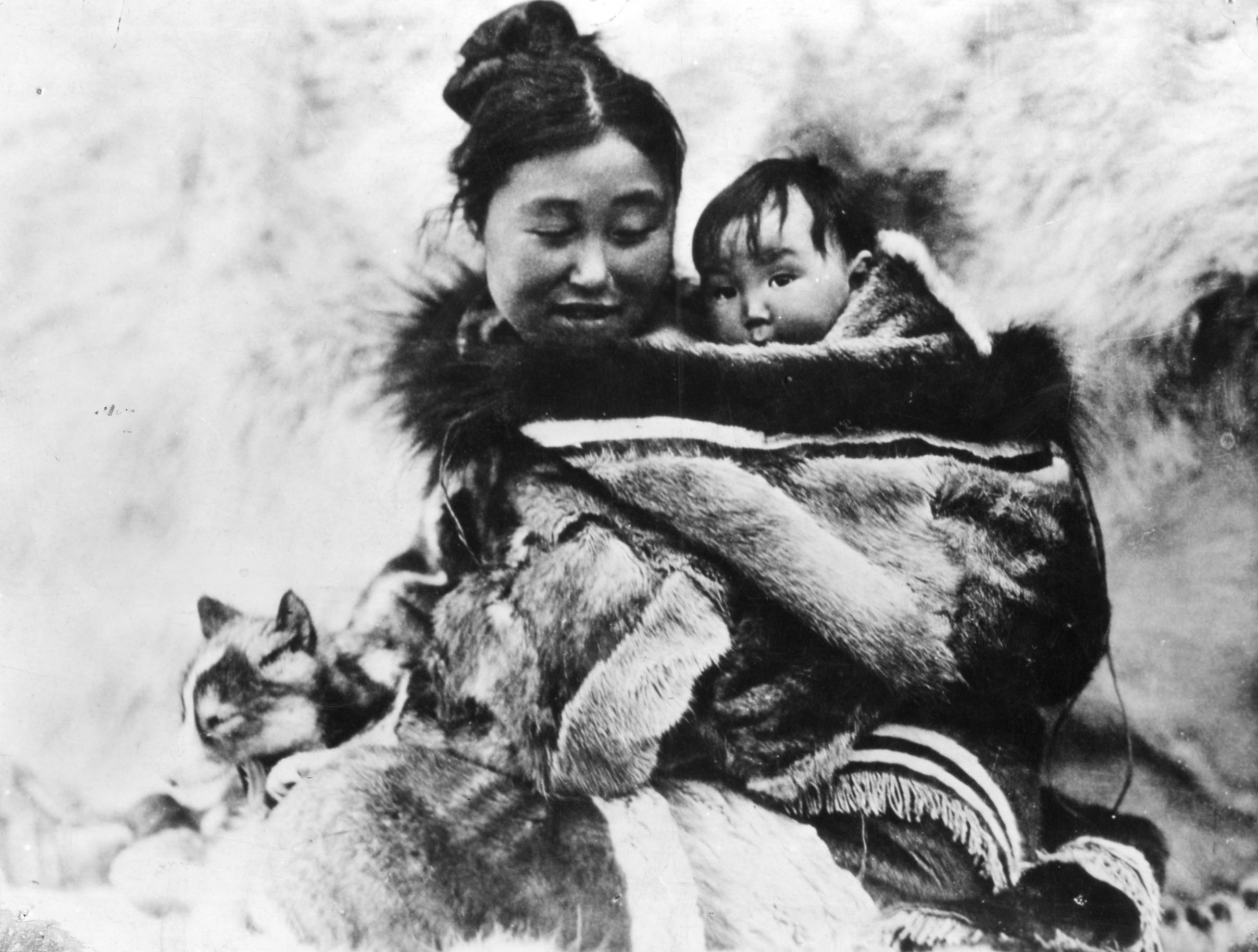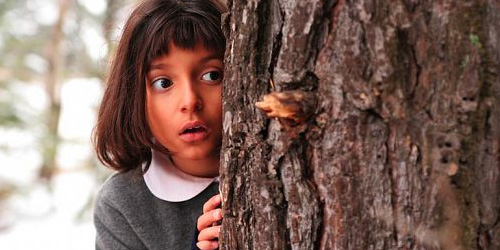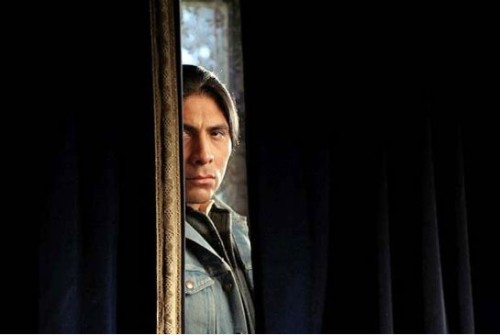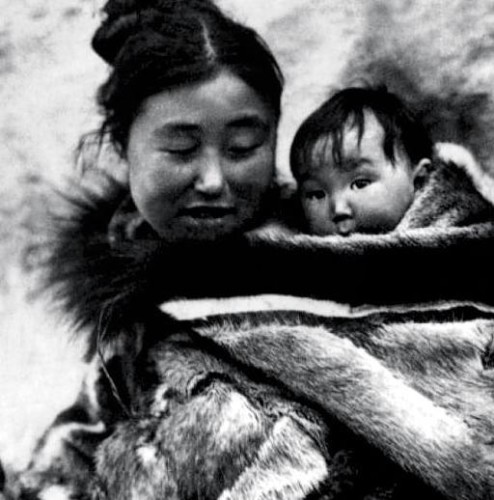This post written by staff writer Brigit McCone originally appeared at Bitch Flicks and is reposted here as part of our theme week on Indigenous Women.
Nanook of the North is an iconic 1922 drama that recreates traditional Inuit lifeways through the representative struggles of Nanook (“Polar Bear,” played by Allakariallak), his wife Nyla (“The Smiling One,” played by Maggie Nujarluktuk), another woman identified only as “Cunayou,” Nanook’s young son “Allee,” and baby “Rainbow.” However, we are shown older boys, described as “some of Nanook’s children,” eating sea-biscuits and lard at the trading post, adding to the film’s casual, hand-waving vagueness about Nanook’s family relationships. Male helpers pop up for group hunts, as though from nowhere, but Nanook’s family is never placed in a wider community context. Despite describing Nanook as band leader, he is never depicted leading, and is frequently infantilized by director Robert Flaherty. By framing his drama as “documentary,” Flaherty converts Allakariallak and Nujarluktuk from active collaborators into passive subjects.
Flaherty erased the fact that both Maggie Nujarluktuk and, reportedly, the woman playing Cunayou, were his own wives (or “mistresses,” from Flaherty’s cultural perspective). The “morning” scene, in which Nanook, his two women and his son awake naked inside the igloo, therefore closely resembles Flaherty’s own polyamorous living arrangement, exoticized into a symptom of Nanook’s cultural Otherness. The domestic warmth that Flaherty captured in Nanook of the North, through his access to both women, is key to his “documentary’s” charm, but his pretended objectivity converts this intensely personal intimacy into an image of the women’s indiscriminate availability to outsiders. Maggie Nujarluktuk smiles self-consciously and playfully flirts with the camera, because the camera is being operated by her husband, but that husband disowns her smiles and essentializes them as a permanent characteristic of “Nyla the smiling one.”
In her thesis, “Neither Indian Princesses Nor Squaw Drudges,” Janice Acoose examines the pervasive stereotype of the “loose squaw” in literature about Indigenous women, which constructs the Indigenous woman as a disposable sexual convenience. Flaherty’s own concept of Inuit disposability was demonstrated when he abandoned Nujarluktuk after filming, who then bore him a son, Josephie, that he never saw, acknowledged, or materially supported. This adds sinister resonance to Nanook of the North‘s description of Nyla’s baby Rainbow as “her young husky,” jokingly implying that Inuit women view their own children as equivalent to animals. In Acoose’s view, “loose squaw” images “foster cultural attitudes that legitimize rape and other similar kinds of violence against Indigenous women,” whose disappearances often go uninvestigated in Canada, particularly if they are also sex workers.
[youtube_sc url=”https://www.youtube.com/watch?v=dCEzGouiy2Q”]
Josephie Flaherty’s family was caught up in the “High Arctic Relocation,” the forced transfer of a community of Inuit to the High Arctic, as “human flagpoles” to support Canada’s territorial claim to the Northwest Passage. It was masterminded by the Department of Northern Affairs, who wished to remove the Inuit from white civilization to free them from “a toxic culture of dependence.” In other words, like Nanook of the North, the “High Arctic Relocation” was an artificially staged, Euro-American vision of uncorrupted Inuit innocence. It is impossible to draw a neat line between Flaherty’s fictional vision and the Department of Northern Affairs’ imposed reality; each was inspired by a toxic culture, not of dependence but of colonial entitlement and the romanticizing of “noble savages”; the Department’s resident romantics may even have been directly inspired by Nanook of the North. The High Arctic Exiles were denied material support from the Canadian government, though that same government intervened to prevent them from hunting on its designated “wildlife preserve.” The Inuit, identified by numbered tags, were taken from a community with a school and nursing station, and transported on a boat with infectious tuberculosis patients. Tuberculosis was also the disease that had previously claimed the life of Flaherty’s star, Allakariallak, a fact that Flaherty covered up by telling audiences that “Nanook” had “starved to death” while hunting deer, yet again erasing Euro-American influence. Several of the High Arctic Exiles’ children were taken from their parents for medical treatment and “misplaced for several years” by bureaucrats, a chilling indifference that echoes Flaherty’s casual attitude to Nanook’s fluctuating number of “young huskies.” For his monument symbolizing victims of the “Relocation,” Inuk sculptor Looty Pijamini chose a life-size Inuk woman and child, carved from a block of granite tinted red like blood.
Her international recording career has made “Inuk punk” Tanya Tagaq into one of the most recognizable cultural ambassadors of the Inuit people. Tagaq’s own mother hailed from Nanook of the North‘s Quebec location before falling victim to the High Arctic “relocation,” informing Tagaq’s complex response to the film’s mixture of colonial ideology and preserved history. In 2012, the Toronto International Film Festival commissioned Tagaq to provide an original soundtrack to the film, drawing from the Inuit art of throat-singing, katajjaq. Discussing the film, Tagaq spotlights Flaherty’s staged scene of Nanook biting a gramophone record, as though unaware of what it is. “Inuit are running the cameras a lot of the time,” Tagaq laughs. Watching this scene closely is revealing. As the gramophone starts up, neither Nanook nor Nyla appears surprised by it, while Nyla rocks her baby to the music. There is an awkward jump cut, Nyla has been removed from the shot, and Nanook is laughing and biting the record. In such scenes, Allakariallak demonstrates the comic ability which gives the film its charm, but is harnessed to create a demeaning image of Inuit childishness, which Flaherty frames as generally representative of “the fearless, lovable, happy-go-lucky Eskimo,” rather than individually representative of the talented comedian, Allakariallak. However, Tanya Tagaq’s soundtrack rejects Flaherty’s impulse to isolate, essentialize, and fossilize Inuit culture into artificial purity. As a confident inheritor of her own culture, she engages with the musical traditions of other nations, harnessing non-Native technology and instruments to enrich her evolving practice of katajjaq.
When the show came to the 2014 Dublin Fringe Festival, I eagerly checked it out, having experienced the masculine tradition of Tuvan khöömei throat-singing in Siberia. Unlike khöömei, katajjaq evolved as a female tradition. Two women, facing each other, would improvise rhythmic motifs, the loser being the first to laugh or run out of breath. These throat-singing games tended to last between one and three minutes. Tagaq’s live performance to Nanook of the North lasts over an hour, an extraordinarily demanding tour-de-force of physical strength and passion.
Katajjaq blends mood, rhythm and the imitation of natural sounds, from wind to howling dogs to crying birds, weaving them into a spiritual whole. By blending the sounds of the natural world with the mind’s vibrations, katajjaq reflects the worldview of animism, the traditional Inuit conception that all objects and beings are endowed with spirit. From the 1930s to the 1960s, Christian missionaries banned throat-singing as a demonic and sexual act. Certainly, Tagaq’s version of katajjaq is strikingly sexual. Her hyperventilations build in intensity and peak with shrieking cries, inducing ecstatic trance. Where “Nyla the smiling one” was crafted as a submissive image of availability, the throat-singer powerfully (perhaps threateningly) voices her own desire. Nina Segalowitz, a survivor of coerced adoption and forced assimilation, found katajjaq an empowering tool for reconnecting to her heritage. Her story recalls the Australian Aboriginal experience of forced assimilation portrayed in Rabbit Proof Fence: “My father thought he was signing hospital admission forms. The next day, he came to take me back, but I was gone. They told him that he had signed release papers and couldn’t get me back.” Evie Mark, raised Inuk but with a white father, also describes the craving for something that will make your identity stronger as a major motivator for katajjaq revival, indicating its importance to national self-esteem. Placed against the imagery of Nanook of the North, katajjaq collapses the distance between spectator and subject, dismantling the subject’s perceived quaintness and giving voice to Inuit experience and perception, from the shrieking killing of a walrus to the grunting effort of igloo construction.
[youtube_sc url=”https://www.youtube.com/watch?v=iV-YQSQ1_FE”]
Tanya Tagaq’s reclaiming of Nanook of the North, with music that fuses tradition and modernity, may be compared with the work of A Tribe Called Red, a collective of First Nations DJs who have collaborated with Tagaq, that remix traditional chanting and drumming with electronica, dubstep, and spoken word, rejecting the impulse to isolate, essentialize, and fossilize. A Tribe Called Red’s visuals (start two minutes in) remix stereotypes of “Red Indians” from pop culture, with witty juxtapositions that subvert their original associations and assert A Tribe Called Red’s authorship. Genocidal policies of forced assimilation, from prohibitions by Christian missionaries to coerced adoptions and residential schools (whose painful legacy is depicted in Cree director Georgina Lightning’s Older Than America, among other Indigenous filmmakers), interrupt the line of cultural transmission in oral cultures, so that the imperial culture’s anthropological records can become the only source of preserved heritage. In reframing a colonial record of Inuit life into an expression of Inuit experience, Tagaq’s voicing of Nanook of the North can be compared to the art of Jane Ash Poitras (Cree), which reframes anthropological photographs by symbolically visualizing the subject’s own perspective. One of her Inuit artworks, “In My Parka You Will Find My Spirit,” offers multiple symbolic frames for her young Inuk subject. First, he is surrounded with the syllabic writing of his own language, inuktitut, whose flowing edges are contained by a rigid frame bearing the imposed Euro-American label “Copper Eskimo.” The outer frame is looped with blood, suggesting interior flesh, while the Arctic exterior, with ghostly inukshuk, is placed inside this flesh, the body experiencing the environment rather than the environment defining the body. On the lower left, an elder represents connection to cultural tradition through role models, an experience stolen from the victims (and survivors) of Canada’s policy of coerced adoption, as recently as the 1960s and 1970s.
Robert Flaherty not only framed Inuit womanhood according to his fantasies of casual sensuality, but according to Euro-American patriarchal fantasy. His portrait of Inuit life is neatly divided between the woman’s role, limited to cleaning igloos and nursing infants, apparently immune to the frustrations of Euro-American women in that role, and the man’s role, leading the band, educating older children, and hunting. In reality, Inuit women were hunters, including polar bear hunters, and played strong roles as educators and storytellers, while today’s Inuit women are also lawyers, government ministers, and activists.
Nanook of the North established the Inuk man as the sole icon of Inuit life. It was followed by 1934’s Wedding of Palo, a portrait of Greenland Inuit by Danish filmmakers, in which the Inuk woman is a love object fought over by two rivals. Though brilliantly filmed, and preserving authentic Inuit traditions, the film reinforces perceptions of Indigenous women as natural spoils of war, submissively accepting their role as the victor’s rightful property. The Inuit-made Atanarjuat: The Fast Runner (2001) does portray the frustration of its heroine, Atuat, at being promised to villain Oki rather than her beloved Atanarjuat. Nevertheless, the story centers Atanarjuat’s experiences, and it is he must find a way to marry the heroine. The short film Kajutaijuq, co-written and produced by Nyla Innuksuk, also centers a male hunter but, hopefully, the rise of promising female filmmakers like Innuksuk will lead to more representations of Inuit women’s perspectives in future. In the meantime, Tanya Tagaq’s voicing of Nanook of the North is a powerful start.
[youtube_sc url=”https://www.youtube.com/watch?v=m4kOIzMqso0″]
Brigit McCone is still decolonizing her mind. She writes and directs short films, radio dramas, and “The Erotic Adventures of Vivica” (as Voluptua von Temptitillatrix). Her hobbies include doodling and telling people to check out the carvings of Susan Point.

















